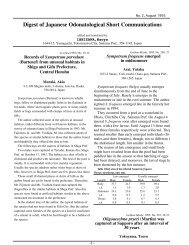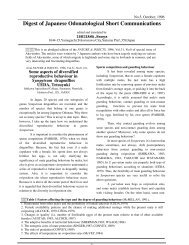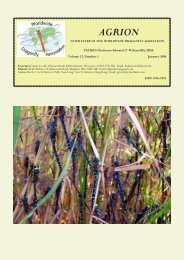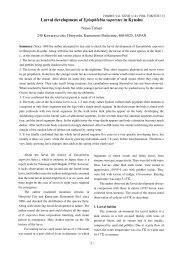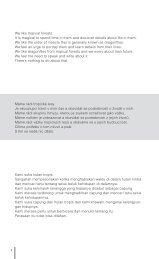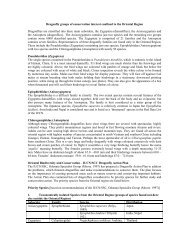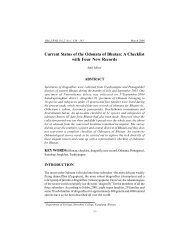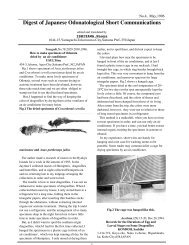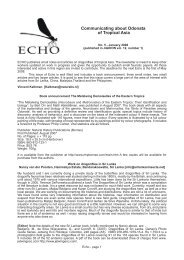ECHO n°6 - Asia Dragonfly
ECHO n°6 - Asia Dragonfly
ECHO n°6 - Asia Dragonfly
Create successful ePaper yourself
Turn your PDF publications into a flip-book with our unique Google optimized e-Paper software.
Fig. 5. Male of Rhinocypha moultoni from ‘Kina Balu, Borneo,<br />
Stdg.’ in Coll. Selys, furnished with identity label ‘Rhinoc. tenera,<br />
S.’ by Selys (labels not shown).<br />
Echo - page 8<br />
Poring in Mt Kinabalu National Park in<br />
April 1994 and April 2000 (Fig. 4). I had<br />
earlier compared my specimens with<br />
the ‘allotype’ of R. moultoni at BMNH<br />
(London), the other mature female<br />
specimen in Laidlaw’s original type series<br />
and found them to agree in all respects.<br />
Thus, I am inclined to conclude that the<br />
stygia female and the mature female of<br />
moultoni (sensu Laidlaw) must refer to<br />
the same species – stygia.<br />
Stygia, moultoni and cognata:<br />
connections revealed<br />
Laidlaw’s (1920) conclusion (see above)<br />
that the colour of the dorsal side of<br />
abdomen in moultoni female changes to<br />
black during maturation does not seem to<br />
be correct. In Selys’ collection there are<br />
a male (Fig. 5) and a female specimen<br />
(Fig. 6) of moultoni from Mt Kinabalu (also<br />
received from Staudinger & Bang-Haas,<br />
and undoubtedly originally acquired from<br />
John Waterstradt). These specimens<br />
bear Selys’ manuscript name Rhinocypha<br />
tenera, but placed under an incorrect<br />
drawer label ‘Libellago tenuis, Selys n.sp.’<br />
(in Selys’ handwriting). The male is fully<br />
mature and the female at least ‘nearly’<br />
mature. In spite of this, the female has<br />
conspicuous brick-red patches on the<br />
dorsum of the abdomen, as in the male.<br />
There is no sign of the reddish dorsal<br />
colouring disappearing in this female<br />
specimen approaching full maturation.<br />
Fig. 6. Female of Rhinocypha moultoni from ‘Kina Balu, Borneo,<br />
The colour pattern of head and thorax<br />
Stdg.’ in Coll. Selys, furnished with identity label ‘Rhinoc. tenera,<br />
are almost identical to that in stygia, but<br />
S.’ by Selys (labels not shown).<br />
the pterostigmata are distinctly paler than<br />
in stygia female (and in moultoni male),<br />
especially in the hindwing.<br />
Kimmins (1969) selected a male specimen as the lectotype of moultoni. Thus there are no direct<br />
taxonomic consequences of the fact that the two female specimens in the original type series of moultoni studied<br />
by Laidlaw (1915) are not conspecific with the male, but belong to stygia. One of these females in the collections<br />
of BMNH (London) is<br />
labelled as ‘allotype’ of<br />
moultoni. On the other<br />
hand the teneral female(s)<br />
listed and illustrated<br />
in Laidlaw (1920) is<br />
(are) real moultoni. My<br />
published record of<br />
‘apparent moultoni’ from<br />
Poring at Mt Kinabalu<br />
(Hämäläinen 1994) is<br />
herewith corrected to<br />
represent stygia. Also<br />
my photo of ‘moultoni’<br />
female laying eggs (at<br />
Poring in April 2000) in<br />
Orr’s (2003, p. 52, Fig.<br />
57) book Dragonflies of<br />
Borneo shows stygia.<br />
So it seems that<br />
Huisman & van Tol (1989)<br />
were correct in assuming<br />
that stygia and cognata<br />
might be synonyms. Orr<br />
(1996) used the name<br />
stygia for this species<br />
while describing the<br />
territorial behaviour of<br />
some chlorocyphids in<br />
Fig. 7. Rhinocypha stygia male. Borneo, Sarawak, Mt Dulit, Sg. Nuam, 30 March<br />
2006. Photo by Graham Reels.



